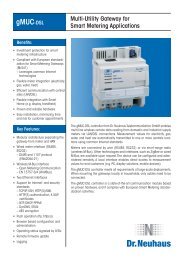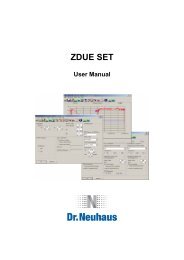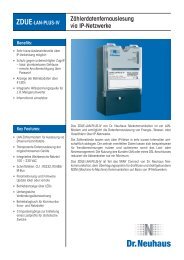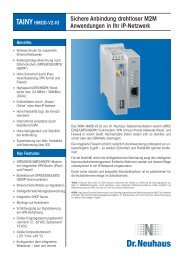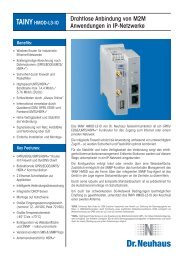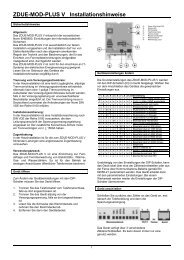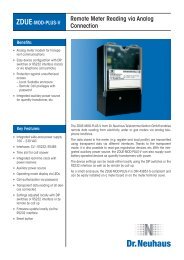tainy hmod-v3-io, tainy hmod-l3-io - Dr. Neuhaus ...
tainy hmod-v3-io, tainy hmod-l3-io - Dr. Neuhaus ...
tainy hmod-v3-io, tainy hmod-l3-io - Dr. Neuhaus ...
You also want an ePaper? Increase the reach of your titles
YUMPU automatically turns print PDFs into web optimized ePapers that Google loves.
Small lexicon of routers<br />
CSQ / RSSI The CSQ value is a value defined in the GSM standard for indicating the<br />
signal quality. CSQ values correspond to the received field strength RSSI<br />
(= Received Signal Strength Indicat<strong>io</strong>n):<br />
Datagram<br />
CSQ RSSI<br />
< 6 < -101 dBm<br />
6 - 10 -101 … - 93 dBm<br />
11 – 18 - 91 dBm … -77 dBm<br />
> 18 > 75 dBm<br />
99 Not logged in<br />
In the transmiss<strong>io</strong>n protocol TCP/IP, data are sent in the form of data<br />
packets, the so-called IP datagrams. An IP datagram has the following<br />
structure:<br />
1. IP Header<br />
2. TCP/UDP Header<br />
3. Data (Payload)<br />
The IP Header contains:<br />
� the IP address of the sender (source IP address)<br />
� the IP address of the recipient (destinat<strong>io</strong>n IP address)<br />
� the protocol number of the protocol of the next higher protocol layer<br />
(according to the OSI layer model)<br />
� the IP Header Checksum for checking the integrity of the header upon<br />
receipt.<br />
TCP/UDP Header contains the following informat<strong>io</strong>n:<br />
� the port of the sender (source port)<br />
� the port of the recipient (destinat<strong>io</strong>n port)<br />
� a checksum for the TCP Header and a few items of informat<strong>io</strong>n from<br />
the IP Header (source and destinat<strong>io</strong>n IP addresses, etc.<br />
DES / 3DES The symmetric encrypt<strong>io</strong>n algorithm (� symmetric encrypt<strong>io</strong>n) DES,<br />
originating from IBM and tested by the NSA, was established in 1997 by the<br />
American Nat<strong>io</strong>nal Bureau of Standards, the predecessor to today's Nat<strong>io</strong>nal<br />
Institute of Standards and Technology (NIST) as a standard for American<br />
governmental institut<strong>io</strong>ns. Since it was the first standardised encrypt<strong>io</strong>n<br />
algorithm, it was also quickly adopted in industrial applicat<strong>io</strong>ns in the US and<br />
beyond.<br />
DES works with a key length of 56bit, which can no longer be considered to<br />
be secure due to the increase in computing capability of the computer since<br />
1977.<br />
3DES is a variant of DES. It works with keys three times the size, which are<br />
168 bits long. It is still considered to be secure and is also a part of the IPsec<br />
standard, among other things.<br />
TAINY xMOD Page 97 of 111






